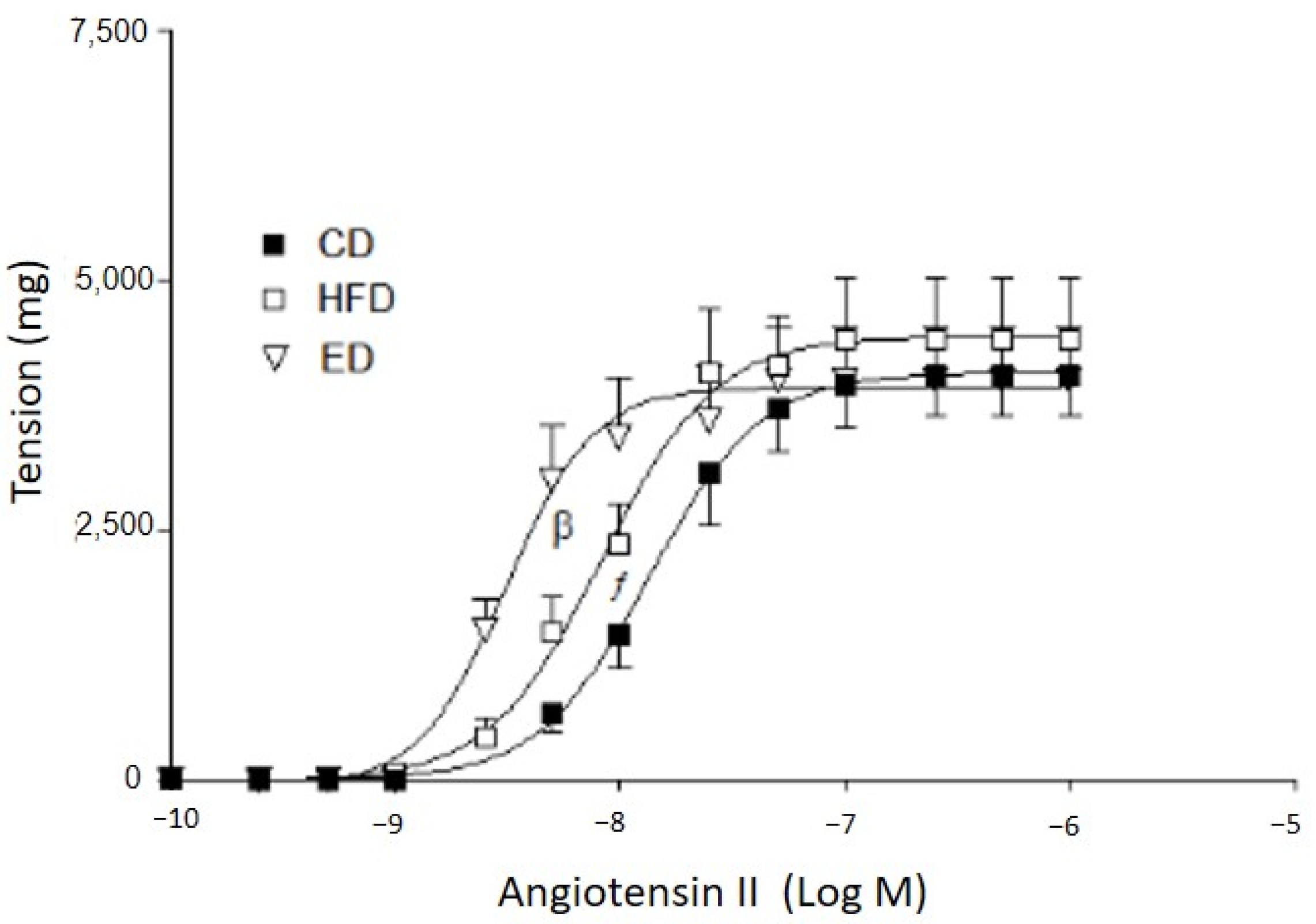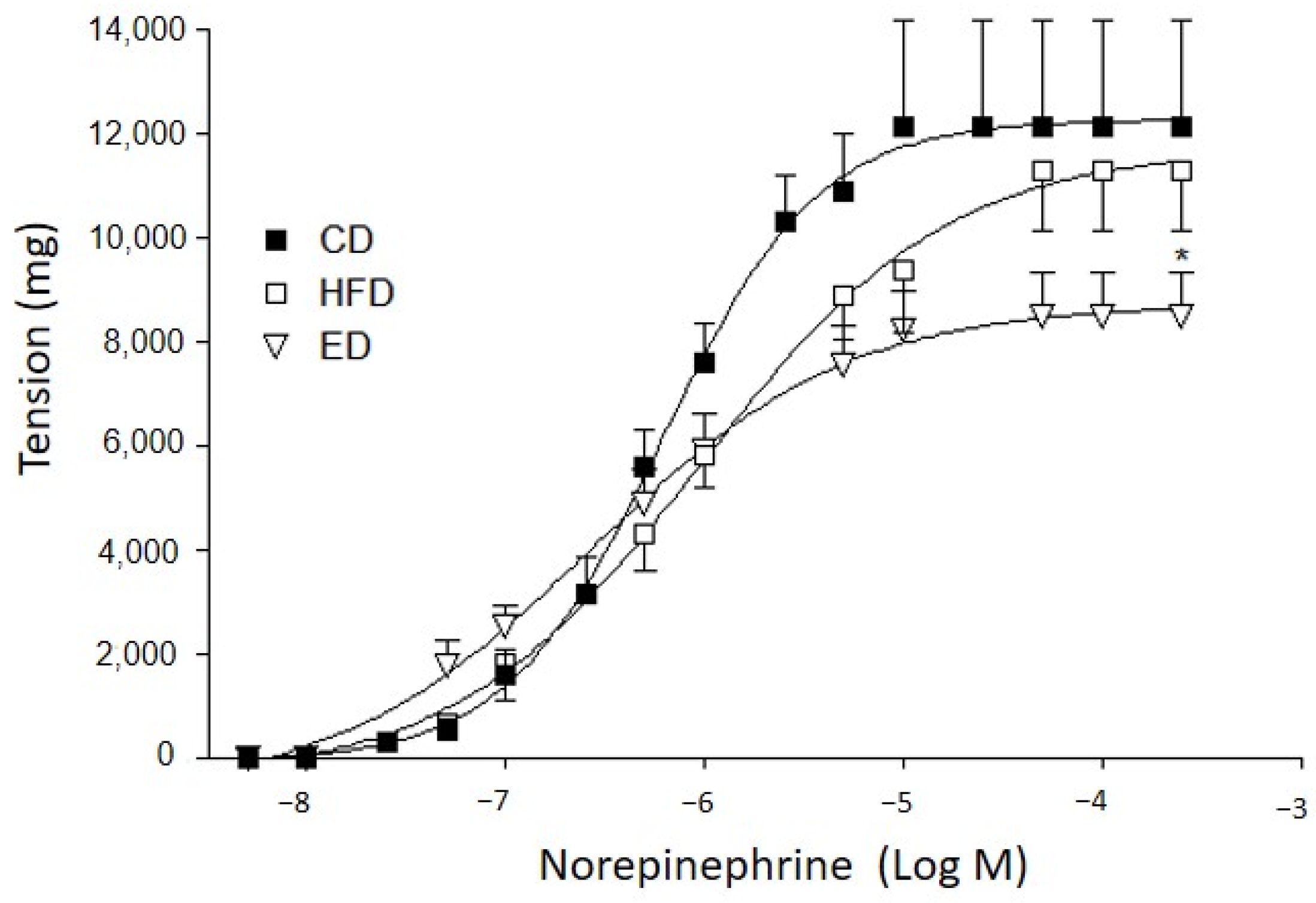Study of the Residue from Salvia hispanica (Chia) Seed Oil Extraction by Cold Pressing for Repurposing as Functional Food to Prevent Metabolic Syndrome †
Abstract
1. Introduction
2. Materials and Methods
2.1. Chia Expeller
2.2. Animal Handling and Diets
2.3. Preparation of Rich-in-Expeller Diet
2.4. Proximate Composition of Expeller and Rich-in-Expeller Diet
2.5. Clinical and Biochemical Parameters
2.6. Vascular Function Assessment
2.7. Statistical Analyses
3. Results
3.1. Composition of Expeller and Rich-in-Expeller Diet
3.2. Clinical and Biochemical Parameters
3.3. Effects of Diets on Acetylcholine Relaxation Responses
3.4. Effect of Diets on Contractile Response to Agonists
4. Discussion
5. Conclusions
Author Contributions
Funding
Institutional Review Board Statement
Informed Consent Statement
Data Availability Statement
Acknowledgments
Conflicts of Interest
References
- Instituto Nacional de Tecnología Industrial. El Valor de los Residuos: Distintos Modos de Reducir, Reutilizar, Reciclar y Revalorizar Residuos Industriales, 1st ed.; Instituto Nacional de Tecnología Industrial: Buenos Aires, Argentine, 2016; Available online: https://www.inti.gob.ar/publicaciones/descargac/1 (accessed on 20 May 2022).
- Cotabarren, J.; Rosso, A.; Tellechea, M.; García-Pardo, J.; Rivera, J.L.; Obregón, W.D.; Parisi, M.G. Adding value to the chia (Salvia hispanica L.) expeller: Production of bioactive peptides with antioxidant properties by enzymatic hydrolysis with Papain. Food Chem. 2019, 274, 848–856. [Google Scholar] [CrossRef] [PubMed]
- Capitani, M.; Spotorno, V.; Nolasco, S.; Tomas, M. Physicochemical and functional characterization of by-products from chia (Salvia hispanica L.) seeds of Argentina. LWT-Food Sci. Technol. 2012, 45, 94–102. [Google Scholar] [CrossRef]
- Coronel, E.; Guiotto, E.; Aspiroz, M.; Tomas, M.; Nolasco, S.; Capitani, M. Development of gluten-free premixes with buckwheat and chia flours: Application in a bread product. LWT-Food Sci. Technol. 2021, 141, 110916. [Google Scholar] [CrossRef]
- Fahed, G.; Aoun, L.; Zerdan, B.M.; Allam, S.; Bou Zerdan, M.; Bouferraa, Y.; Assi, H.I. Metabolic Syndrome: Updates on Pathophysiology and Management in 2021. Int. J. Mol. Sci. 2022, 23, 786. [Google Scholar] [CrossRef]
- Alarcón, G.; Roco, J.; Medina, A.; Sierra, L.; Medina, M.; Jerez, S. High fat diet-induced metabolically obese and normal weight rabbit model shows early vascular dysfunction: Mechanisms involved. Int. J. Obes. 2018, 42, 1535–1543. [Google Scholar] [CrossRef] [PubMed]
- Alarcón, G.; Medina, A.; Martin Alzogaray, F.; Medina, M.; Roco, J.; Jerez, S. Partial replacement of corn oil with chia oil into a high fat diet produces either beneficial and deleterious effects on metabolic and vascular alterations in rabbits. PharmaNutrition 2020, 14, 100218. [Google Scholar] [CrossRef]
- Chicco, A.G.; D’Alessandro, M.E.; Hein, G.J.; Oliva, M.E.; Lombardo, Y.B. Dietary chia seed (Salvia hispanica L.) rich in alpha-linolenic acid improves adiposity and normalises hypertriacylglycerolaemia and insulin resistance in dyslipaemic rats. Br. J. Nutr. 2009, 101, 41–50. [Google Scholar] [CrossRef] [PubMed]
- San Pablo-Osorio, B.; Mojica, L.; Urías-Silvas, J.E. Chia Seed (Salvia hispanica L.) Pepsin Hydrolysates Inhibit Angiotensin-Converting Enzyme by Interacting with its Catalytic Site. J. Food Sci. 2019, 84, 1170–1179. [Google Scholar] [CrossRef] [PubMed]
- Limberg, J.K.; Soares, R.N.; Power, G.; Harper, J.L.; Smith, J.A.; Shariffi, B.; Jacob, D.W.; Manrique-Acevedo, C.; Padilla, J. Hyperinsulinemia blunts sympathetic vasoconstriction: A possible role of β-adrenergic activation. Am. J. Physiol. Regul. Integr. Comp. Physiol. 2021, 320, R771–R779. [Google Scholar] [CrossRef] [PubMed]


| Expeller | ED | |
|---|---|---|
| Moisture | 4.5 ± 0.3 | 5.8 ± 0.6 |
| Lipid | 9.1 ± 1.1 | 7.6 ± 2.1 |
| Protein | 29.9 ± 0.06 | 14.1 ± 0.4 |
| Ash | 5.2 ± 0.24 | 7.82 ± 0.18 |
| CD | HFD | ED | |
|---|---|---|---|
| Body Weight (g) | 1940 ± 149 | 2043 ± 46 | 2059 ± 79 |
| Visceral abdominal fat (%) | 1.09 ± 0.17 | 2.31 ± 0.14 a | 2.85 ± 0.22 a |
| Fasting Glucose (mg/dL) | 113.0 ± 3.0 | 126.1 ± 5.8 a | 90.0 ± 7.7 b |
| Total Cholesterol (mg/dL) | 59.0 ± 6.0 | 77.7 ± 4.8 a | 54 ± 8 b |
| LDL-cholesterol (mg/dL) | 29.0 ± 7.8 | 39.8 ± 7.2 | 15.47 ± 3.6 b |
| HDL-cholesterol (mg/dL) | 51.5 ± 6.9 | 24.2 ± 2.8 a | 22 ± 4.8 a,b |
| Triacylglycerol (mg/dL) | 105 ± 14 | 192 ± 22 a | 94 ± 15 b |
| TyG index | 8.3 ± 0.2 | 9.3 ± 0.3 a | 8.3 ± 0.2 b |
| Blood pressure (mmHg) | 56.0 ± 2.6 | 56.7 ± 5.3 | 40.0 ± 6.3 a,b |
| Heart rate (bpm) | 265 ± 25 | 281.8 ± 27 | 306 ± 47 |
Publisher’s Note: MDPI stays neutral with regard to jurisdictional claims in published maps and institutional affiliations. |
© 2022 by the authors. Licensee MDPI, Basel, Switzerland. This article is an open access article distributed under the terms and conditions of the Creative Commons Attribution (CC BY) license (https://creativecommons.org/licenses/by/4.0/).
Share and Cite
Alarcon, G.; Valoy, A.; Rossi, A.; Jerez, S. Study of the Residue from Salvia hispanica (Chia) Seed Oil Extraction by Cold Pressing for Repurposing as Functional Food to Prevent Metabolic Syndrome. Biol. Life Sci. Forum 2022, 17, 13. https://doi.org/10.3390/blsf2022017013
Alarcon G, Valoy A, Rossi A, Jerez S. Study of the Residue from Salvia hispanica (Chia) Seed Oil Extraction by Cold Pressing for Repurposing as Functional Food to Prevent Metabolic Syndrome. Biology and Life Sciences Forum. 2022; 17(1):13. https://doi.org/10.3390/blsf2022017013
Chicago/Turabian StyleAlarcon, Gabriela, Agostina Valoy, Analia Rossi, and Susana Jerez. 2022. "Study of the Residue from Salvia hispanica (Chia) Seed Oil Extraction by Cold Pressing for Repurposing as Functional Food to Prevent Metabolic Syndrome" Biology and Life Sciences Forum 17, no. 1: 13. https://doi.org/10.3390/blsf2022017013
APA StyleAlarcon, G., Valoy, A., Rossi, A., & Jerez, S. (2022). Study of the Residue from Salvia hispanica (Chia) Seed Oil Extraction by Cold Pressing for Repurposing as Functional Food to Prevent Metabolic Syndrome. Biology and Life Sciences Forum, 17(1), 13. https://doi.org/10.3390/blsf2022017013






